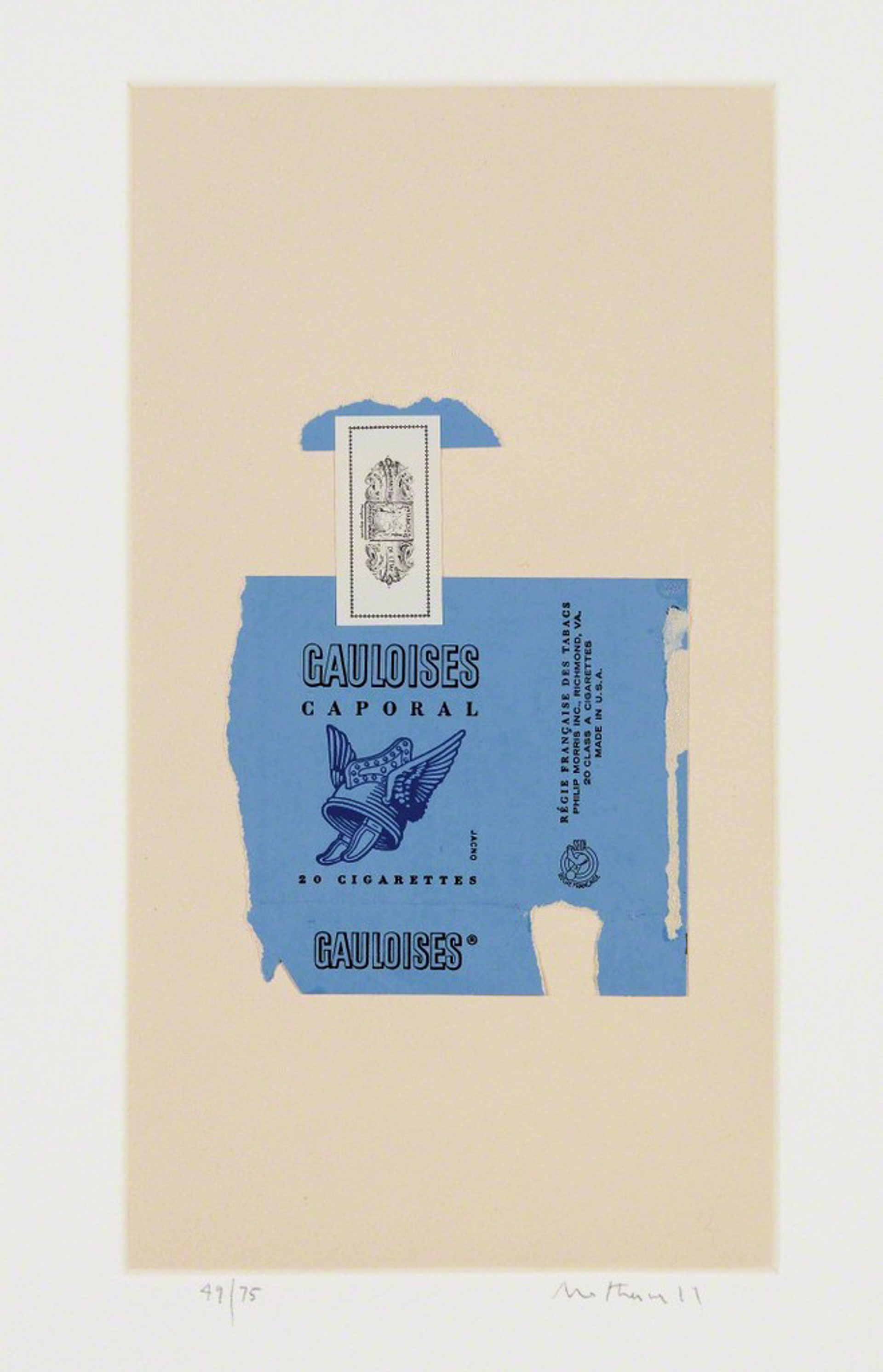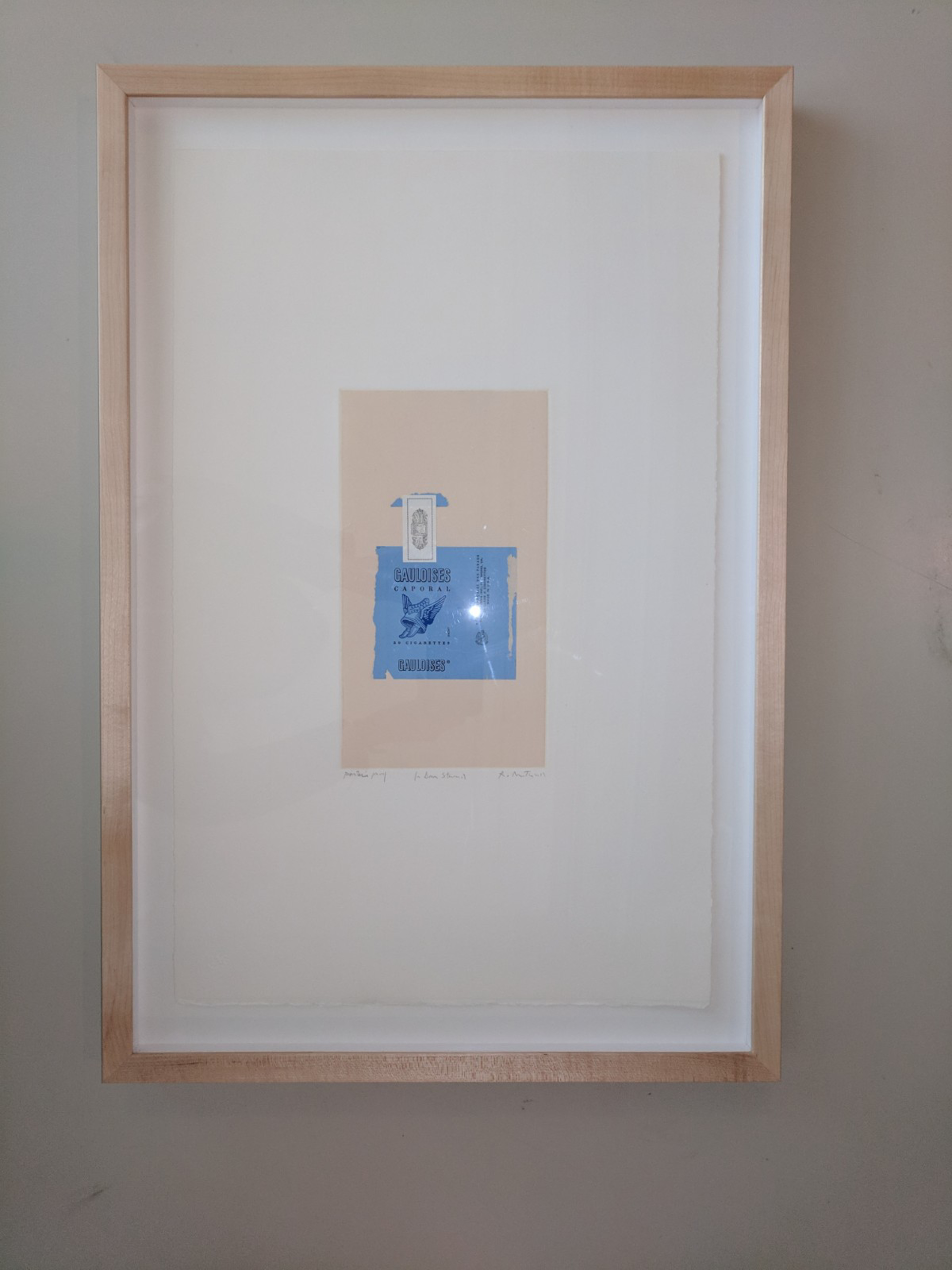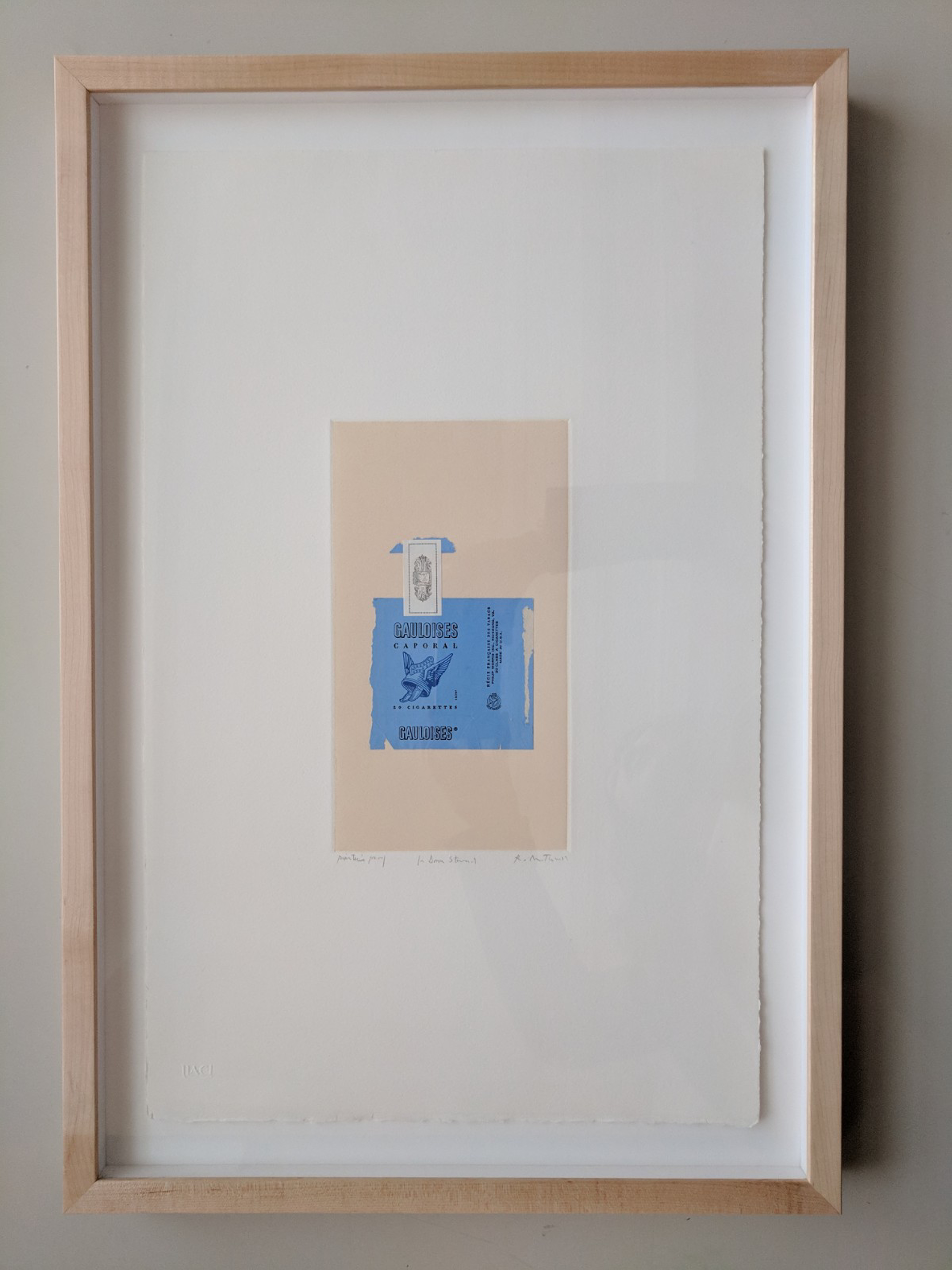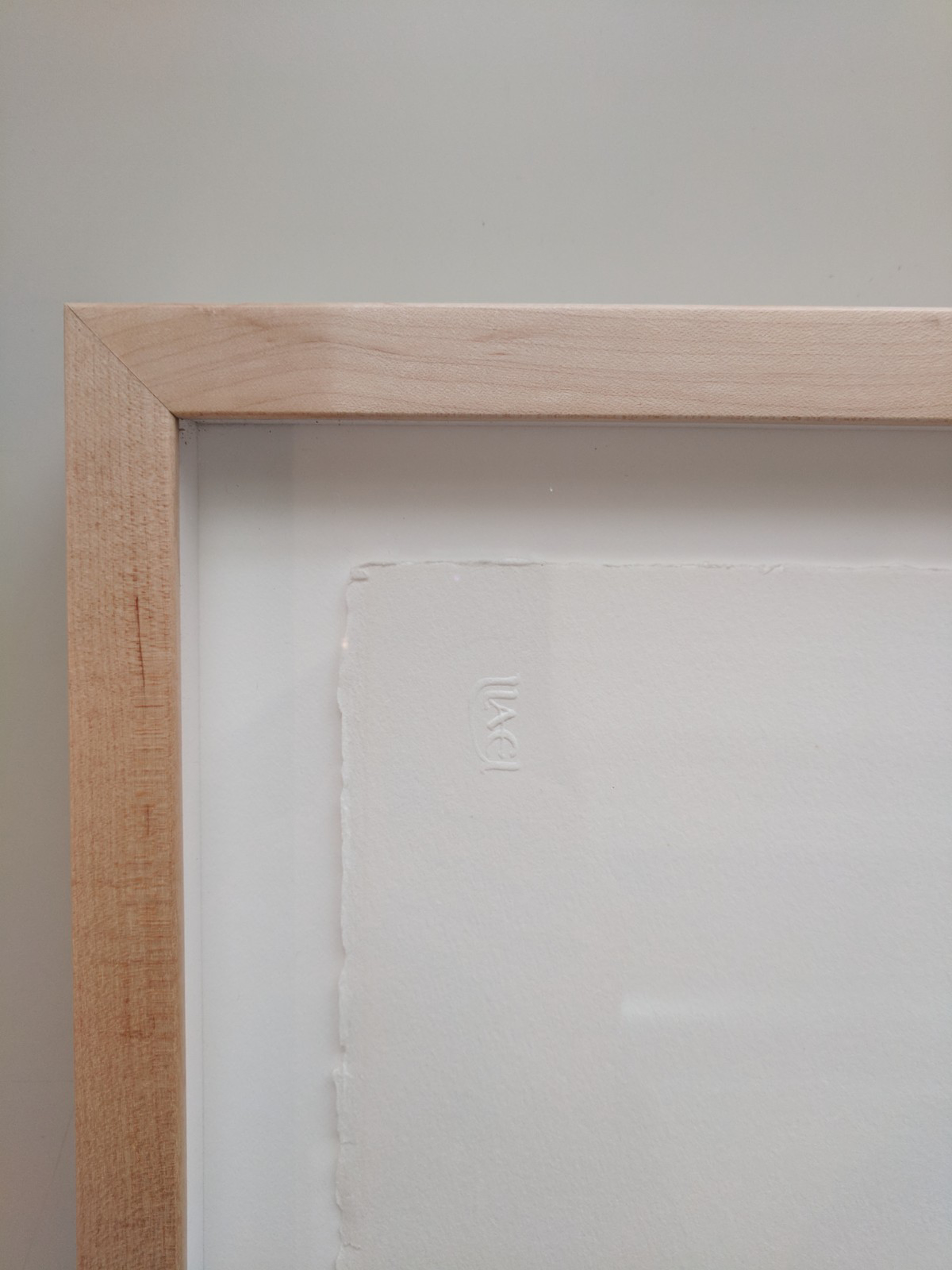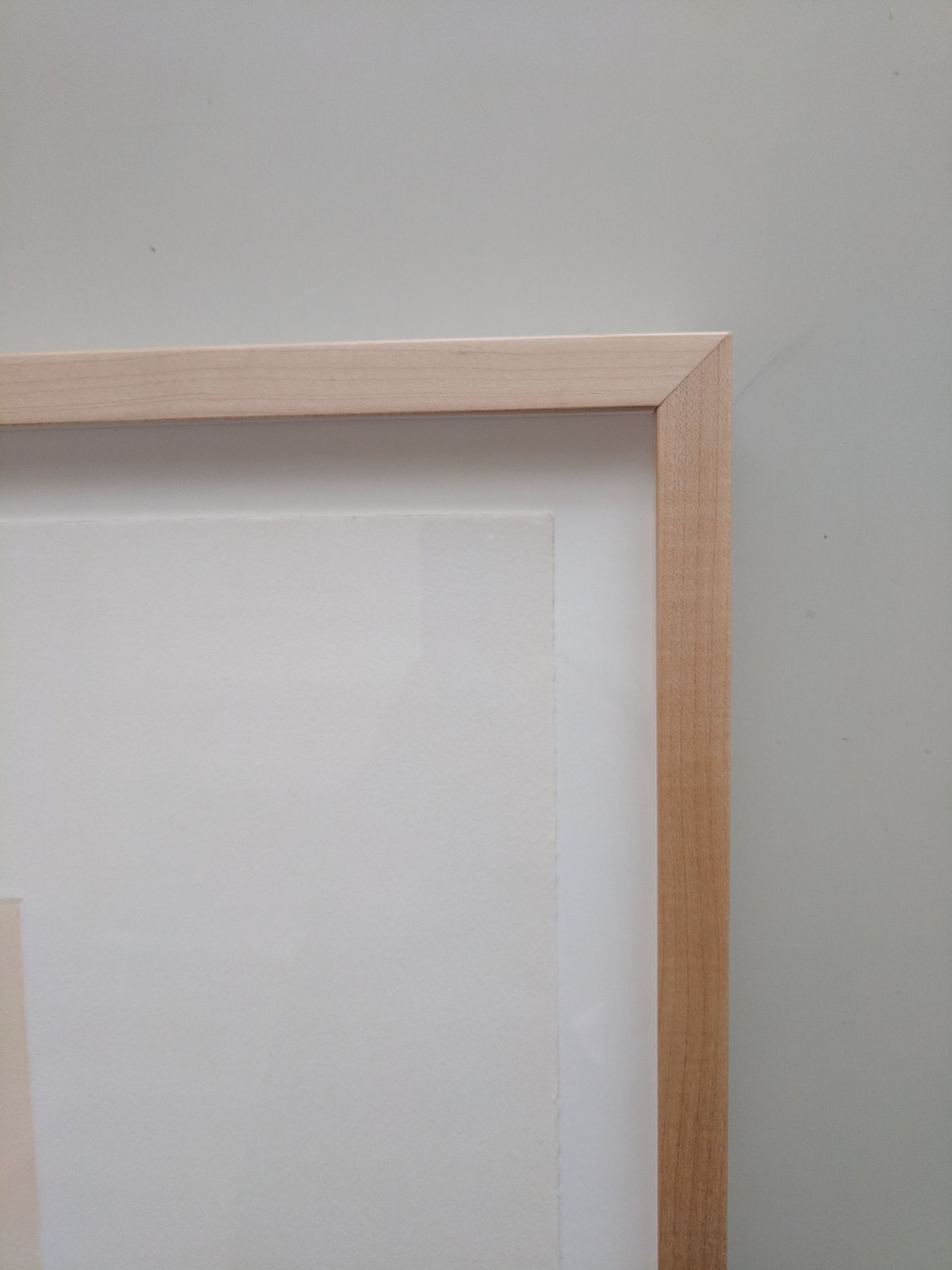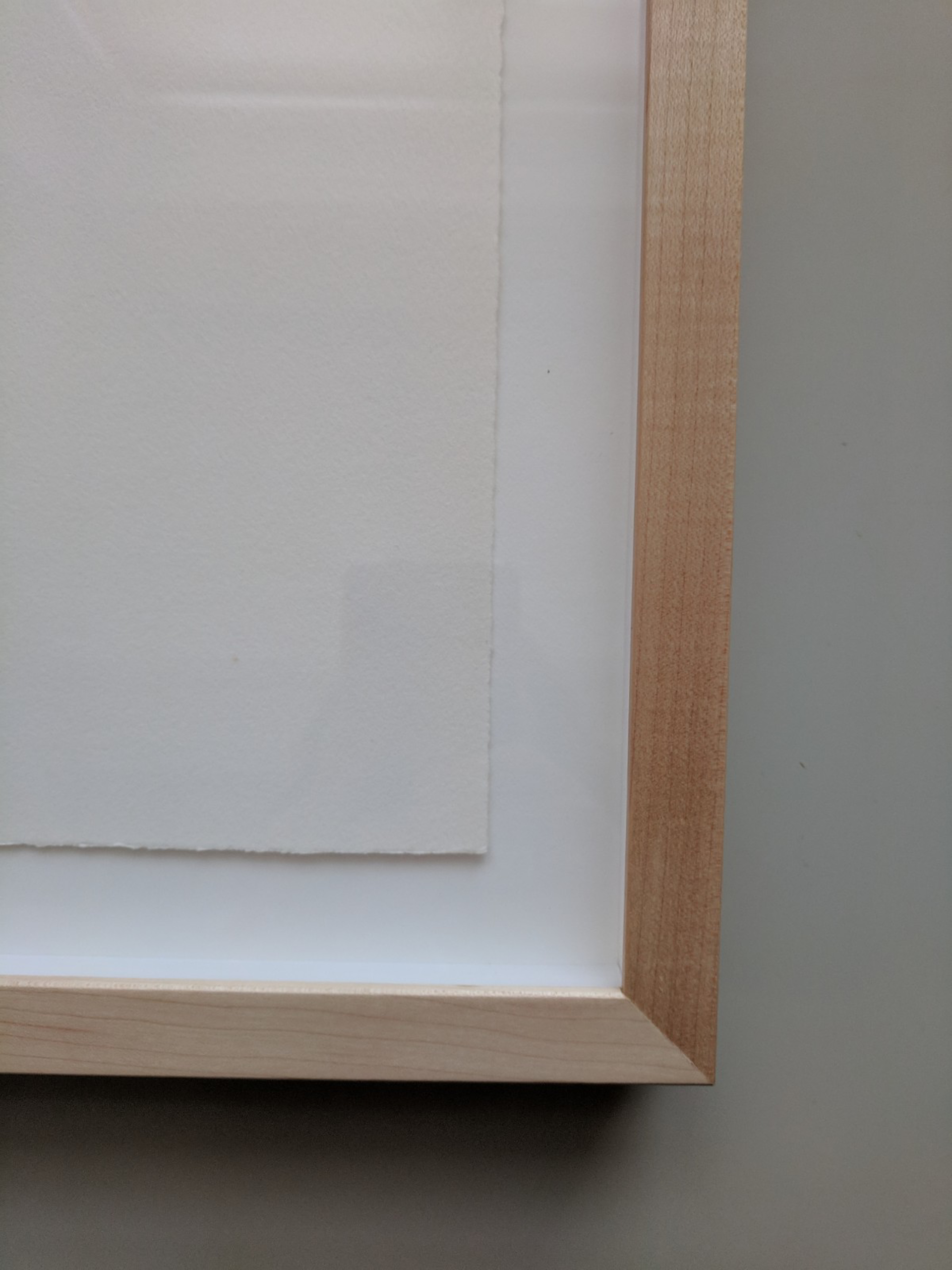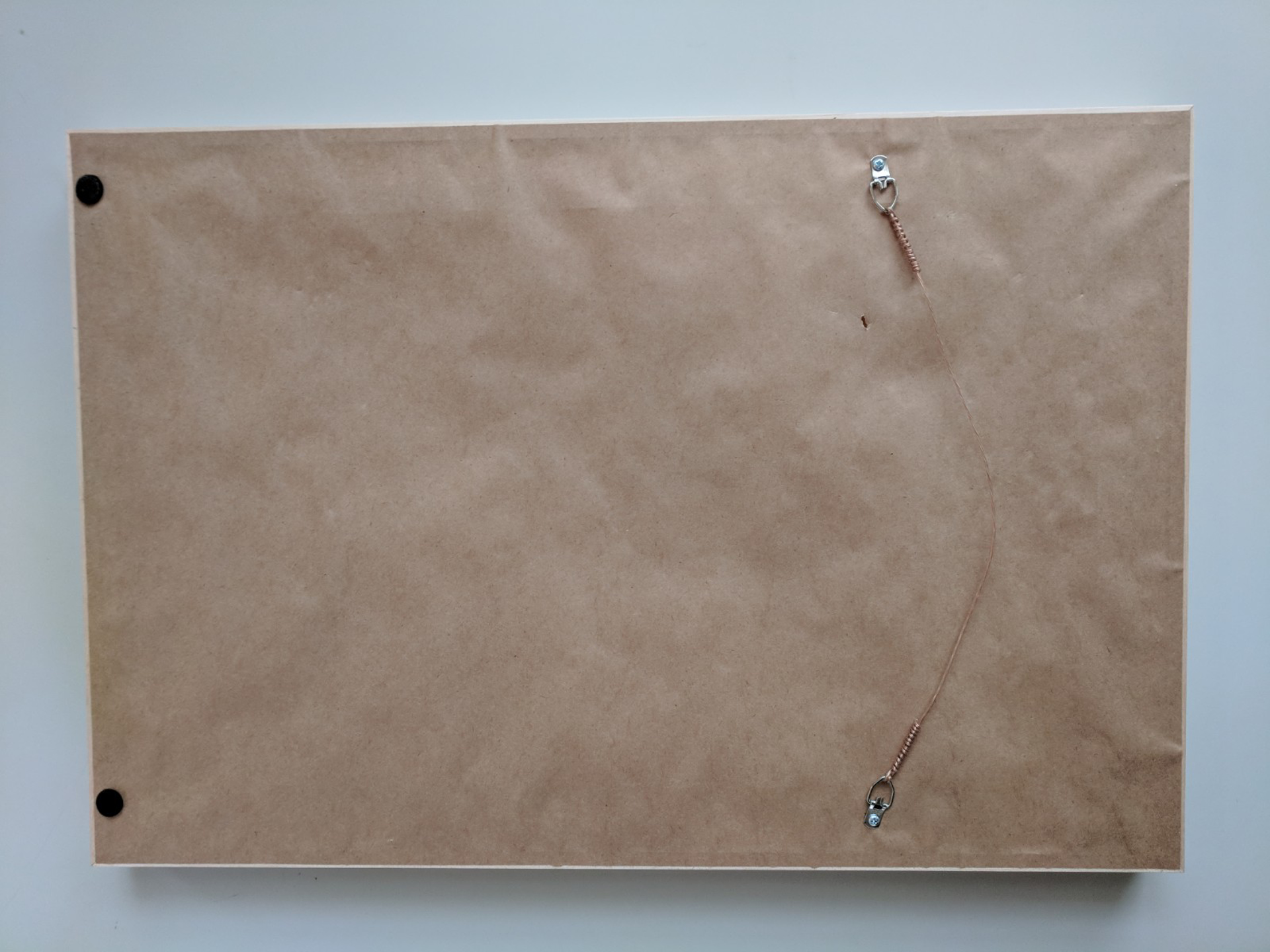Robert Motherwell (American, 1915 - 1991)
Gauloises Bleues (1/75), 1968
Aquatint with collaged blue Gauloises cigarette package label on white wove Dutch Copperplate Etching paper
22 x 14.50 in
Sold
Framed
Signed, numbered and dedicated in pencil. Signed “R. Motherwell, lower right; dedicated “for Donn Steward”, lower middle; numbered “printer’s proof”, lower left; publisher's seal embossed, lower left.
Printed by Donn Steward, New York
Published by Universal Limited Art Editions, New York
Catalogue Raisonne Number: Engberg & Banach 59
Literature:
Belknap, Dorothy & Terenzio, Stephanie (1980) The Painter and the Printer: Robert Motherwell’s Graphics. New York, New York: American Federation of Arts.
Belknap, Dorothy & Terenzio, Stephanie (2009) The Prints of Robert Motherwell. New York, New York: Hudson Hills Press.
Engberg, Siri & Banach, Joan (2003) Robert Motherwell: The Complete Prints 1940-1991: Catalogue Raisonne. New York, New York: Hudson Hills Press.
Sparks, Ester (1989) Universal Limited Art Editions: A History and Catalogue, the First Twenty-Five Years. Chicago, Illinois: Art Institute of Chicago.
University of Missouri-St. Louis (2010) Robert Motherwell, the College Prints, 1968-1978. St Louis, Missouri: USML Publications Office.
Museum Collections:
Gauloises Bleues can be found in the following selected collections: Walker Art Center, Minnesota; the Metropolitan Museum of Art, New York; The Art Institute of Chicago, Illinois; the Museum of Modern Art, New York; The Indianapolis Museum of Art, Indiana; Wesleyan University’s Davison Art Center, Connecticut; the Centre de la Gravure, Belgium; the de Young Museum, San Francisco; the Whitney Museum of American Art, New York; the Hirshhorn Museum and Sculpture Garden, Washington, D.C., among others.
Examples of this work have been exhibited:
New York, The Museum of Modern Art, The Painter and the Printer: Robert Motherwell’s Graphics, Oct 30 – Dec 16, 1980.
New York, Whitney Museum of American Art, Universal Limited Art Editions: A Tribute to Tatyana Grosman, Aug 30 – Sept 28, 1982.
Washington, D.C., Hirshhorn Museum and Sculpture Garden, Smithsonian Institute, Robert Motherwell: Prints and Collages from the Museum’s Collection, Nov 14 – April 12, 1992.
New York, The Metropolitan Museum of Art, Robert Motherwell: Lyric Suite, Feb 2 – July 26, 2015.
Notes:
Proofs include 4 AP, 1 PP, 4 TP, and a number of unrecorded TP, WP and other proofs.
Printed in two steps from one copper plate. Step one, ochre plate onto Dutch Copperplate paper. Step two, collaged Gauloises label, hand-torn by the artist and adhered to printed Dutch Copperplate paper. The collage medium allowed Motherwell to catalogue fragments of commercial packaging that appealed to him. Because of their color or lettering, some wrappers made frequent appearances in his work. One of the most familiar is the French Gauloises cigarette package, incorporated into this print for the first time.
The edition of seventy-five was produced in two segments, approximately sixty-five completed in 1968 and an additional ten in 1972. As these prints were completed, Motherwell decided to distinguish the differences in each by tearing the collage fragments variously. The last ten examples include two cigarette packages each.
Gauloises, "Gaul women" in French ("cigarette" is feminine in French), is a brand of cigarette of French manufacture. It is produced by the company Imperial Tobacco following their acquisition of Altadis in January 2008 in most countries, but produced and sold by Reemtsma in Germany. In March 1954 SEITA launched the “Gauloise Disque Bleu” brand, with CEO Pierre Grimanelli proud of the new packaging that would, he argued, increase sales. The brand has been linked to high-status and inspirational figures representing the worlds of art and the intellectual elite, including Jean-Paul Sartre, Jean Baudrillard, Jim Morrison, Pablo Picasso and many more.
Robert Motherwell used Gauloises packets and cartons in many collages, including an extensive series with the packets surrounded by bright red acrylic paint, often with incised lines in the painted areas. In the introduction to his 2015 book Robert Motherwell, The Making of an American Giant, gallery owner Bernard Jacobson says, "Motherwell smoked Lucky Strikes, but in his collage life he smokes Gauloises, around whose blue packets he now organises one composition after another, 'exotic to me precisely because in the normal course of things I don't smoke French cigarettes'." And by incorporating Gauloises packets he makes deft and condensed allusion to "French blue": to the Mediterranean and the palette of Matisse . . . to the smoke coiling up in a Cubist assemblage."
During his career as an artist Robert Motherwell produced nearly 460 prints, influencing countless artists with his innovative ideas and printmaking techniques, and a considerable number of them contain some element of collaged material or the implication of such layering of image and paper.
Collage, as an art form, is truly a 20th century innovation. Of all the printmaking artists of the last century, Motherwell made the most of collage as an editioned art form, creating slight variations within editions using a common matrix of placement and substitution. Sometimes this takes the form of replicated bits of found paper that Motherwell used to such great effect in his unique works. To that end, the artist selected various wine, cheese, paper or cigarette labels that printmaking studios then faithfully reproduced on acid-free paper. This way the artist could eliminate the possibility for disintegration common with found materials, thereby ensuring long-term archival quality.
Creating the collage effects in these prints is done by tearing or cutting the re-printed papers around templates designed by the artist and then pasting the resulting scraps in a uniform manner to the surfaces of his prints. Other types of collage materials utilize special papers chosen by the artist or even proofs from previously editioned prints containing images or textures desired by the artist. Depending on the specific print, this collaging work is done by the studio’s master printers matching the artist’s specifications or, in some cases, by the artist himself.
Excerpt from the Museum of Modern Art, New York’s The Painter and the Printer: Robert Motherwell’s Graphics Press Release:
Motherwell, best known for his work in painting and collage, turned to printmaking, in part, to escape the solitude of the studio. His investigation of the medium soon led to a deeper involvement, as he developed an understanding of its complexities.
His respect for the printers, “who selflessly and sensitively become the artist’s alter ego, seeing through the artist’s own eyes,” is limitless. And he delights as much in the materials themselves as in the challenges of “collaborative art.” Printmaking has, for Motherwell, a certain freshness, directness and economy of means not to be found in most other mediums. Finally, Motherwell enjoys printmaking’s dual personality. As he has said, “though prints, in being multiples, are potentially the most public of an artist’s expression, in my case I had always regarded them as the most private – not only because prints are generally intimate in scale and technique, but also making them tended to be more sportif than my work in collage and painting.”
Excerpt from Universal Limited Art Editions: A Tribute to Tatyana Grosman on aquatint:
“. . . the master printer in the engraving workshop at Mrs. Grosman 's, Donn Steward, introduced me to aquatint. . . . Over four years, Steward's sensitivity of technical response to my intentions, as well as
suggestions and even anticipations (so closely did we work together) was sustained in a way that I would not have thought possible. In the midst of this technological era, one of my cherished experiences has been to work with a great and meticulous craftsman. . . .”
Quote from Robert Motherwell, 1971:
“I remember when in the last few years I made a series of aquatints with the Gauloises blue cigarette package—because I love that blue as part of the image—Helen Frankenthaler looking at me with stupefaction and saying, ‘I can’t imagine you being a Pop artist.’ And certainly from the French point of view it must look like Pop Art. To me it looked as exotic as Tahiti must have looked to French travelers.”
Biography:
Robert Motherwell was born January 24, 1915, in Aberdeen, Washington. He was awarded a fellowship to the Otis Art Institute in Los Angeles at age 11, and in 1932 studied painting briefly at the California School of Fine Arts in San Francisco. Motherwell received a B.A. from Stanford University in 1937 and enrolled for graduate work later that year in the Department of Philosophy at Harvard University, Cambridge, Massachusetts. He traveled to Europe in 1938 for a year of study abroad. His first solo show was presented at the Raymond Duncan Gallery in Paris in 1939.
In September of 1940, Motherwell settled in New York, where he entered Columbia University to study art history with Meyer Schapiro, who encouraged him to become a painter. In 1941, Motherwell traveled to Mexico with Roberto Matta for six months. After returning to New York, his circle came to include William Baziotes, Willem de Kooning, Hans Hofmann, and Jackson Pollock. In 1942, Motherwell was included in the exhibition First Papers of Surrealism at the Whitelaw Reid Mansion, New York. In 1944, Motherwell became editor of the Documents of Modern Art series of books, and he contributed frequently to the literature on Modern art from that time.
A solo exhibition of Motherwell’s work was held at Peggy Guggenheim’s Art of This Century gallery, New York, in 1944. In 1946, he began to associate with Herbert Ferber, Barnett Newman, and Mark Rothko, and spent his first summer in East Hampton, Long Island. Recently, Motherwell was given solo exhibitions at the Arts Club of Chicago and the San Francisco Museum of Art, and he participated in Fourteen Americans at the Museum of Modern Art in New York. The artist subsequently taught and lectured throughout the United States, and continued to exhibit extensively in the United States and abroad. A Motherwell exhibition took place at the Kunsthalle Düsseldorf, the Museum des 20. Jahrhunderts, Vienna, and the Musée d’Art Moderne de la Ville de Paris in 1976–77. He was given important solo exhibitions at the Royal Academy, London, and the National Gallery of Art, Washington, D.C., in 1978. A retrospective of his works organized by the Albright-Knox Art Gallery, Buffalo, New York, traveled in the United States from 1983 to 1985. From 1971, the artist lived and worked in Greenwich, Connecticut. He died July 16, 1991, in Cape Cod, Massachusetts.
Printed by Donn Steward, New York
Published by Universal Limited Art Editions, New York
Catalogue Raisonne Number: Engberg & Banach 59
Literature:
Belknap, Dorothy & Terenzio, Stephanie (1980) The Painter and the Printer: Robert Motherwell’s Graphics. New York, New York: American Federation of Arts.
Belknap, Dorothy & Terenzio, Stephanie (2009) The Prints of Robert Motherwell. New York, New York: Hudson Hills Press.
Engberg, Siri & Banach, Joan (2003) Robert Motherwell: The Complete Prints 1940-1991: Catalogue Raisonne. New York, New York: Hudson Hills Press.
Sparks, Ester (1989) Universal Limited Art Editions: A History and Catalogue, the First Twenty-Five Years. Chicago, Illinois: Art Institute of Chicago.
University of Missouri-St. Louis (2010) Robert Motherwell, the College Prints, 1968-1978. St Louis, Missouri: USML Publications Office.
Museum Collections:
Gauloises Bleues can be found in the following selected collections: Walker Art Center, Minnesota; the Metropolitan Museum of Art, New York; The Art Institute of Chicago, Illinois; the Museum of Modern Art, New York; The Indianapolis Museum of Art, Indiana; Wesleyan University’s Davison Art Center, Connecticut; the Centre de la Gravure, Belgium; the de Young Museum, San Francisco; the Whitney Museum of American Art, New York; the Hirshhorn Museum and Sculpture Garden, Washington, D.C., among others.
Examples of this work have been exhibited:
New York, The Museum of Modern Art, The Painter and the Printer: Robert Motherwell’s Graphics, Oct 30 – Dec 16, 1980.
New York, Whitney Museum of American Art, Universal Limited Art Editions: A Tribute to Tatyana Grosman, Aug 30 – Sept 28, 1982.
Washington, D.C., Hirshhorn Museum and Sculpture Garden, Smithsonian Institute, Robert Motherwell: Prints and Collages from the Museum’s Collection, Nov 14 – April 12, 1992.
New York, The Metropolitan Museum of Art, Robert Motherwell: Lyric Suite, Feb 2 – July 26, 2015.
Notes:
Proofs include 4 AP, 1 PP, 4 TP, and a number of unrecorded TP, WP and other proofs.
Printed in two steps from one copper plate. Step one, ochre plate onto Dutch Copperplate paper. Step two, collaged Gauloises label, hand-torn by the artist and adhered to printed Dutch Copperplate paper. The collage medium allowed Motherwell to catalogue fragments of commercial packaging that appealed to him. Because of their color or lettering, some wrappers made frequent appearances in his work. One of the most familiar is the French Gauloises cigarette package, incorporated into this print for the first time.
The edition of seventy-five was produced in two segments, approximately sixty-five completed in 1968 and an additional ten in 1972. As these prints were completed, Motherwell decided to distinguish the differences in each by tearing the collage fragments variously. The last ten examples include two cigarette packages each.
Gauloises, "Gaul women" in French ("cigarette" is feminine in French), is a brand of cigarette of French manufacture. It is produced by the company Imperial Tobacco following their acquisition of Altadis in January 2008 in most countries, but produced and sold by Reemtsma in Germany. In March 1954 SEITA launched the “Gauloise Disque Bleu” brand, with CEO Pierre Grimanelli proud of the new packaging that would, he argued, increase sales. The brand has been linked to high-status and inspirational figures representing the worlds of art and the intellectual elite, including Jean-Paul Sartre, Jean Baudrillard, Jim Morrison, Pablo Picasso and many more.
Robert Motherwell used Gauloises packets and cartons in many collages, including an extensive series with the packets surrounded by bright red acrylic paint, often with incised lines in the painted areas. In the introduction to his 2015 book Robert Motherwell, The Making of an American Giant, gallery owner Bernard Jacobson says, "Motherwell smoked Lucky Strikes, but in his collage life he smokes Gauloises, around whose blue packets he now organises one composition after another, 'exotic to me precisely because in the normal course of things I don't smoke French cigarettes'." And by incorporating Gauloises packets he makes deft and condensed allusion to "French blue": to the Mediterranean and the palette of Matisse . . . to the smoke coiling up in a Cubist assemblage."
During his career as an artist Robert Motherwell produced nearly 460 prints, influencing countless artists with his innovative ideas and printmaking techniques, and a considerable number of them contain some element of collaged material or the implication of such layering of image and paper.
Collage, as an art form, is truly a 20th century innovation. Of all the printmaking artists of the last century, Motherwell made the most of collage as an editioned art form, creating slight variations within editions using a common matrix of placement and substitution. Sometimes this takes the form of replicated bits of found paper that Motherwell used to such great effect in his unique works. To that end, the artist selected various wine, cheese, paper or cigarette labels that printmaking studios then faithfully reproduced on acid-free paper. This way the artist could eliminate the possibility for disintegration common with found materials, thereby ensuring long-term archival quality.
Creating the collage effects in these prints is done by tearing or cutting the re-printed papers around templates designed by the artist and then pasting the resulting scraps in a uniform manner to the surfaces of his prints. Other types of collage materials utilize special papers chosen by the artist or even proofs from previously editioned prints containing images or textures desired by the artist. Depending on the specific print, this collaging work is done by the studio’s master printers matching the artist’s specifications or, in some cases, by the artist himself.
Excerpt from the Museum of Modern Art, New York’s The Painter and the Printer: Robert Motherwell’s Graphics Press Release:
Motherwell, best known for his work in painting and collage, turned to printmaking, in part, to escape the solitude of the studio. His investigation of the medium soon led to a deeper involvement, as he developed an understanding of its complexities.
His respect for the printers, “who selflessly and sensitively become the artist’s alter ego, seeing through the artist’s own eyes,” is limitless. And he delights as much in the materials themselves as in the challenges of “collaborative art.” Printmaking has, for Motherwell, a certain freshness, directness and economy of means not to be found in most other mediums. Finally, Motherwell enjoys printmaking’s dual personality. As he has said, “though prints, in being multiples, are potentially the most public of an artist’s expression, in my case I had always regarded them as the most private – not only because prints are generally intimate in scale and technique, but also making them tended to be more sportif than my work in collage and painting.”
Excerpt from Universal Limited Art Editions: A Tribute to Tatyana Grosman on aquatint:
“. . . the master printer in the engraving workshop at Mrs. Grosman 's, Donn Steward, introduced me to aquatint. . . . Over four years, Steward's sensitivity of technical response to my intentions, as well as
suggestions and even anticipations (so closely did we work together) was sustained in a way that I would not have thought possible. In the midst of this technological era, one of my cherished experiences has been to work with a great and meticulous craftsman. . . .”
Quote from Robert Motherwell, 1971:
“I remember when in the last few years I made a series of aquatints with the Gauloises blue cigarette package—because I love that blue as part of the image—Helen Frankenthaler looking at me with stupefaction and saying, ‘I can’t imagine you being a Pop artist.’ And certainly from the French point of view it must look like Pop Art. To me it looked as exotic as Tahiti must have looked to French travelers.”
Biography:
Robert Motherwell was born January 24, 1915, in Aberdeen, Washington. He was awarded a fellowship to the Otis Art Institute in Los Angeles at age 11, and in 1932 studied painting briefly at the California School of Fine Arts in San Francisco. Motherwell received a B.A. from Stanford University in 1937 and enrolled for graduate work later that year in the Department of Philosophy at Harvard University, Cambridge, Massachusetts. He traveled to Europe in 1938 for a year of study abroad. His first solo show was presented at the Raymond Duncan Gallery in Paris in 1939.
In September of 1940, Motherwell settled in New York, where he entered Columbia University to study art history with Meyer Schapiro, who encouraged him to become a painter. In 1941, Motherwell traveled to Mexico with Roberto Matta for six months. After returning to New York, his circle came to include William Baziotes, Willem de Kooning, Hans Hofmann, and Jackson Pollock. In 1942, Motherwell was included in the exhibition First Papers of Surrealism at the Whitelaw Reid Mansion, New York. In 1944, Motherwell became editor of the Documents of Modern Art series of books, and he contributed frequently to the literature on Modern art from that time.
A solo exhibition of Motherwell’s work was held at Peggy Guggenheim’s Art of This Century gallery, New York, in 1944. In 1946, he began to associate with Herbert Ferber, Barnett Newman, and Mark Rothko, and spent his first summer in East Hampton, Long Island. Recently, Motherwell was given solo exhibitions at the Arts Club of Chicago and the San Francisco Museum of Art, and he participated in Fourteen Americans at the Museum of Modern Art in New York. The artist subsequently taught and lectured throughout the United States, and continued to exhibit extensively in the United States and abroad. A Motherwell exhibition took place at the Kunsthalle Düsseldorf, the Museum des 20. Jahrhunderts, Vienna, and the Musée d’Art Moderne de la Ville de Paris in 1976–77. He was given important solo exhibitions at the Royal Academy, London, and the National Gallery of Art, Washington, D.C., in 1978. A retrospective of his works organized by the Albright-Knox Art Gallery, Buffalo, New York, traveled in the United States from 1983 to 1985. From 1971, the artist lived and worked in Greenwich, Connecticut. He died July 16, 1991, in Cape Cod, Massachusetts.

